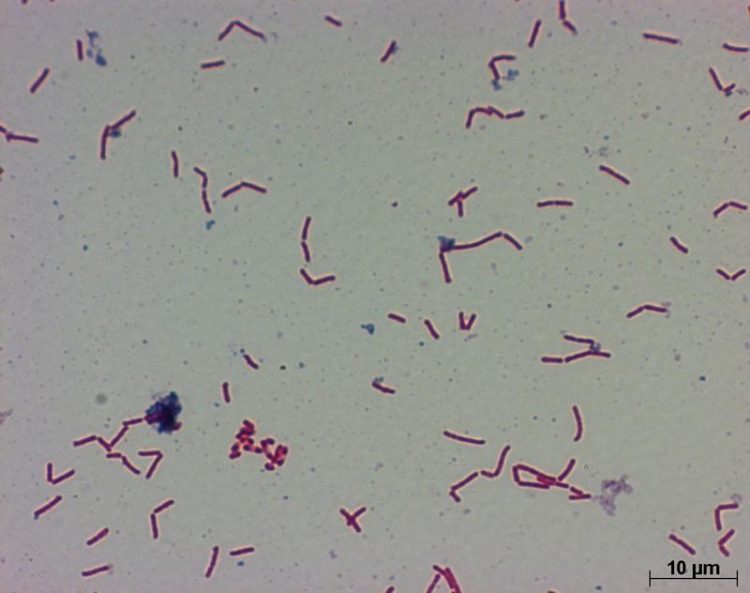Gut bacteria promote obesity in mice

Clostridium ramosum
A research team from the German Institute of Human Nutrition Potsdam-Rehbruecke in Nuthetal observed that mice harboring human gut bacteria including C. ramosum gained weight when fed a high-fat diet. Mice that did not have C. ramosum were less obese even when consuming a high-fat diet, and mice that had C. ramosum but consumed a low-fat diet also stayed lean.
Previous studies have found C. ramosum and other representatives of the Erysipelotrichi class in obese humans, said senior study author Michael Blaut, PhD, head of the institute's Department of Gastrointestinal Microbiology. This suggests that growth of this organism in the digestive tract is stimulated by high-fat diets, which in turn improves nutrient uptake and enhances the effect of such diets on body weight and body fat.
“We were surprised that presence or absence of one species in a defined bacterial community affected body weight and body fat development in mice,” says Blaut.
Blaut and colleagues investigated the role of C. ramosum in three groups of mice: some harbored a simplified human intestinal microbiota (bacteria) of eight bacterial species including C. ramosum; some had simplified human intestinal microbiota except for C. ramosum, and some had C. ramosum only. The researchers called the first group SIHUMI, the second group SIHUMIw/oCra and the third group Cra. Mice were fed either a high-fat diet or low-fat diet for four weeks.
After four weeks eating a high-fat diet, the mouse groups did not differ in energy intake, diet digestibility, and selected markers of low-grade inflammation. However, SIHUMI mice and Cra mice fed a high-fat diet gained significantly more body weight and body fat, which implies that they converted food more efficiently to energy than did the SIHUMIw/oCra mice. By contrast, all groups of mice fed a low-fat diet stayed lean, indicating that the obesity effect of C. ramosum only occurred on high-fat diets.
The obese SIHUMI and Cra mice also had higher gene expression of glucose transporter 2 (Glut2), a protein that enables absorption of glucose and fructose, and fat transport proteins including fatty acid translocase (Cd36).
“Our results indicate that Clostridium ramosum improves nutrient uptake in the small intestine and thereby promotes obesity,” Blaut said. Associations between obesity and increased levels of lipopolysaccharides (components of the cell wall of gram-negative bacteria) causing inflammation, or increased formation of molecules called short chain fatty acids, reported by other researchers, were not found in this study, he said: “This possibly means that there is more than one mechanism underlying the promotion of obesity by intestinal bacteria.”
Through additional studies Blaut said he hopes to learn more about how C. ramosum affects its host's energy metabolism and whether similar results occur in conventional mice given the bacteria. “Unraveling the underlying mechanism may help to develop new strategies in the prevention or treatment of obesity,” he said.
The current study was supported by the German Institute of Human Nutrition Potsdam-Rehbruecke.
mBio® is an open access online journal published by the American Society for Microbiology to make microbiology research broadly accessible. The focus of the journal is on rapid publication of cutting-edge research spanning the entire spectrum of microbiology and related fields. It can be found online at http://mbio.asm.org.
The American Society for Microbiology is the largest single life science society, composed of over 39,000 scientists and health professionals. ASM's mission is to advance the microbiological sciences as a vehicle for understanding life processes and to apply and communicate this knowledge for the improvement of health and environmental and economic well-being worldwide.
Media Contact
All latest news from the category: Life Sciences and Chemistry
Articles and reports from the Life Sciences and chemistry area deal with applied and basic research into modern biology, chemistry and human medicine.
Valuable information can be found on a range of life sciences fields including bacteriology, biochemistry, bionics, bioinformatics, biophysics, biotechnology, genetics, geobotany, human biology, marine biology, microbiology, molecular biology, cellular biology, zoology, bioinorganic chemistry, microchemistry and environmental chemistry.
Newest articles

Silicon Carbide Innovation Alliance to drive industrial-scale semiconductor work
Known for its ability to withstand extreme environments and high voltages, silicon carbide (SiC) is a semiconducting material made up of silicon and carbon atoms arranged into crystals that is…

New SPECT/CT technique shows impressive biomarker identification
…offers increased access for prostate cancer patients. A novel SPECT/CT acquisition method can accurately detect radiopharmaceutical biodistribution in a convenient manner for prostate cancer patients, opening the door for more…

How 3D printers can give robots a soft touch
Soft skin coverings and touch sensors have emerged as a promising feature for robots that are both safer and more intuitive for human interaction, but they are expensive and difficult…





















